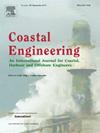基于神经网络的海啸淹没概率评估代理模型
IF 4.5
2区 工程技术
Q1 ENGINEERING, CIVIL
引用次数: 0
摘要
对海啸的淹没深度和分布进行概率评估和不确定性评估对于制定有效的海啸备灾和减灾工作至关重要。然而,基于非线性长波理论的现有方法通常用于分析浅海海啸传播和淹没,计算成本很高,从而限制了其实际应用于概率评估,这需要大量的模拟。在这项研究中,我们提出了一种创新的方法,通过建立一个基于深度神经网络(dnn)的代理模型来减少概率海啸淹没评估的分析负担。利用线性长波理论测试了不同输入,包括地震断层的滑动分布、初始水位分布和水位随时间的分布。结果表明,直接从地震断层的滑动分布预测海啸淹没深度和淹没分布是可能的,而不是从初始水位和随后的海啸水位信息。这些结果表明,只要断层滑动分布的信息是可用的,海啸淹没的深度和分布可以使用一个适当的物理模型模拟结果训练的替代模型即时预测。这一发现可能构成一种突破性的预测方法。如果可以方便地进行淹没深度和分布的概率评估或不确定性评估,则可以促进基于该评估的当地海啸风险评估和各种灾害对策。本文章由计算机程序翻译,如有差异,请以英文原文为准。
A neural network-based surrogate model for efficient probabilistic tsunami inundation assessment
Probabilistic assessment and uncertainty evaluation of the inundation depth and distribution of tsunamis are critical for developing effective tsunami disaster preparedness and mitigation efforts. However, existing approaches based on nonlinear long wave theory, which is commonly used to analyze tsunami propagation and inundation in shallow waters, are computationally expensive, thereby limiting their practical application to probabilistic assessment, which requires numerous simulations. In this study, we propose an innovative method to reduce the analytical burden of probabilistic tsunami inundation assessment by building a surrogate model using deep neural networks (DNNs). Different inputs are tested, including the slip distribution of an earthquake fault, the initial water level distribution, and the water level distribution over time using linear long wave theory. The results show the possibility of predicting the tsunami inundation depths and inundation distributions with some accuracy directly from the slip distributions of earthquake faults rather than from information on initial water levels and subsequent tsunami water levels. These results indicate that, as long as the information on the slip distribution of a fault is available, the tsunami inundation depth and distribution can be instantly predicted using a surrogate model that has appropriately been trained on the outcomes of physical model simulations. This finding may constitute a breakthrough prediction method. If the probabilistic evaluation of the inundation depth and distribution or the evaluation of uncertainty can be easily performed, then local tsunami risk assessment and various disaster countermeasures based on such an assessment can be promoted.
求助全文
通过发布文献求助,成功后即可免费获取论文全文。
去求助
来源期刊

Coastal Engineering
工程技术-工程:大洋
CiteScore
9.20
自引率
13.60%
发文量
0
审稿时长
3.5 months
期刊介绍:
Coastal Engineering is an international medium for coastal engineers and scientists. Combining practical applications with modern technological and scientific approaches, such as mathematical and numerical modelling, laboratory and field observations and experiments, it publishes fundamental studies as well as case studies on the following aspects of coastal, harbour and offshore engineering: waves, currents and sediment transport; coastal, estuarine and offshore morphology; technical and functional design of coastal and harbour structures; morphological and environmental impact of coastal, harbour and offshore structures.
 求助内容:
求助内容: 应助结果提醒方式:
应助结果提醒方式:


